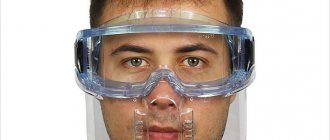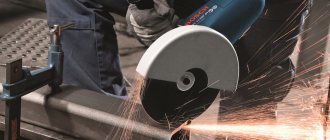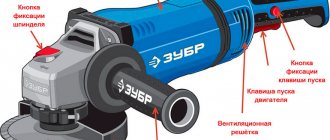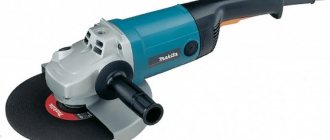An angle grinder, better known as an angle grinder, is a serious and dangerous tool. But it is quite difficult to do without the use of angle grinders during construction and even minor repair work. The use of an angle grinder reduces labor costs and speeds up the process. Therefore, when working with angle grinders, it is extremely important to follow safety precautions. One of the significant points is the protection of the face, because sparks, scale, small particles of metal, grinding disc and other materials can damage the skin and mucous membranes.
Protective glasses
A popular means of protection when working with an angle grinder is special glasses. They come in two types: open and closed.
- Open glasses look like regular ones, but are made of dense materials that can withstand sparks and small debris. Unfortunately, such glasses will not help when working with hard materials, and will not protect you from dust;
- Closed-type safety glasses adhere completely to the skin and prevent dust and any elements from entering the eyes.
Both options have a significant drawback: the glasses do not completely cover the face and are aimed only at protecting the eyes.
Purpose of safety glasses
In addition to the danger of electric shock and injury from rotating elements, when handling an angle grinder, you must be careful of getting all sorts of objects into your eyes. Retinal burns, which can be caused by a hot spark, are quite serious injuries and require medical attention.
Clouds of dust and dirt cause irritation of the mucous membrane and cause eye fatigue. Injuries from sharp shrapnel are common. Any damage to the visual organs or skin is considered an industrial injury. That is why glasses and protective masks for angle grinders are mandatory for use with this and similar devices.
Protective shields
Special shields, or masks, for working with an angle grinder seem to be more reliable, but their cost is higher. Professionals prefer this category of protective equipment, because they protect not only the eyes, but the entire face. Masks come in different types and are made from different materials, which affects their appearance and cost.
The masks are attached using special belts or other fasteners and are held tightly on the head; the protective glass protects against the ingress of scale and dust particles and materials. Some shields have a visor that protects the forehead. In addition, shields are made with a special fine mesh - this is additional protection, including from damage to the mask itself during operation, which increases its service life. Overall, a face shield is more durable than regular glasses.
Personal protective equipment for working with power tools
When purchasing this or that hand-held power tool, how many of you, dear readers, study in detail all sections of the attached instructions? I think not. Usually, reading it is limited to familiarizing yourself with the technical characteristics and how to put IT into operation. Such negligence can have absolutely irreparable consequences. And this is exactly what we would like to dwell on in more detail, and specifically on the need for personal protective equipment when working with various power tools.
Despite the fact that manufacturers are trying their best to protect the tools supplied to the modern market, they still remain quite dangerous.
The threat to life and health is, first of all, electricity itself, working attachments moving at enormous speed (drills, cutting and stripping discs, saws, knives, etc.), their flying fragments, random uncontrolled emissions of chips, shavings and crumbs of the material being processed, dust, noise and vibration.
Today there are a huge number of different means of protection that allow you to preserve hearing, vision, and protect all parts of the body from mechanical and thermal injuries. Perhaps, when using a tool at home, many of them will seem unnecessary, but for professionals they are simply necessary.
Safety glasses and face shields
The modern range of safety glasses is quite large. They vary in material and shape. To work with power tools - angle grinders, circular saws, planes , etc. - glasses with transparent lenses are used. They consist of a body in which the glass is directly attached, and temples. A headband can also be used as a fixing element.
To protect against small solid particles flying from the front and sides, you can limit yourself to open glasses. In case of possible multidirectional emission of solid particles, closed goggles with direct ventilation are preferable. In case of large dust formation, which is typical, for example, when working with grinding machines, or splashing of non-aggressive liquids (for example, during wet grinding), the best option would be closed glasses with indirect ventilation.
Considering the possible impact force of traumatic particles, the speed of which can be 45 m/sec or more, it is better to pay attention to glasses with lenses made of special polycarbonate. They are characterized by high strength and, with proper care, are little susceptible to abrasion.
Safety glasses are selected taking into account the nature of the work to be done and the possibility of individual adjustment for secure fastening on the head. At the same time, there are models that can be used over corrective glasses.
To prevent the glass from fogging up, you can treat it with special compounds, or you can make do with improvised means - rub the inner surface of the glass with baby or glycerin soap and polish it with velvet cloth.
Face shields are more practical because they protect not only the eyes, but also the skin of the face and neck from mechanical damage.
For working with power tools, the most in demand are shields with a head mount and shields with a mount on a helmet (of course, if it is intended to be worn), with movable or fixed glass holders. Such masks are made of durable polycarbonate glass, including three-layer glass, and may contain additional steel mesh.
Respirators and masks
For the most part, power tools intended for work that generates large amounts of dust are equipped with special dust collectors or are equipped with connections for connecting to an industrial vacuum cleaner. But, for example, in drills, rotary hammers and jackhammers, built-in dust extraction systems are quite rare, and in this case the user must take care of respiratory protection himself.
The simplest means of protection in this case can be disposable gauze respirators. They are not burdensome when worn for a long time, but, alas, they are not always effective enough. If you often have to deal with this kind of work, it is better to purchase a professional mask with a replaceable filter. At the same time, full-face masks do not need to be supplemented with protective glasses. Having spent once on the purchase of such an accessory, you will for a long time get rid of the need to swallow dust when cutting and drilling concrete, during intensive work sawing wood, etc.
Hearing protection
It is known that absolutely silent power tools simply do not exist. During operation, they create the most unpleasant impact noise for the ear.
Practice has proven that repeated prolonged exposure to noise levels of 70-90 dB can cause significant weakening or even loss of hearing, and the instructions for most power tools indicate a possible level of 85 dB. This means that during intensive work, personal hearing protection must be used - headphones or earplugs. The choice of both is extremely wide.
Earplugs can be disposable or reusable, with a cord or a hard rim. As for full headphones, you can find electronic ones with the ability to adjust the level of external sounds - suppressing loud ones and enhancing weak ones.
Do you prefer to listen to music while working? And this is not a problem, since there are headphones with a built-in stereo receiver. Communication headphones absorb loud noise while still allowing you to hear normal speech.
Protective aprons and suits
Even if you don’t work with welding, but are just going to cut steel with a grinder, you should get special clothing made of fabric impregnated with a fire retardant compound. Hot sparks generated during the cutting process scatter within a radius of up to 2 meters, burning and igniting easily flammable objects. Oiled overalls that are not intended for this purpose can cause severe burns.
Chainsaws are equipped with a number of protective functions and devices for the safety of the user, however, when working with them is an integral part of professional activity, it makes sense to purchase special trousers containing inserts made of durable fibrous material in the legs. When throwing a saw, the most likely area of injury is the knee-shin area. After the top layer of fabric is torn, the fibers are wound around the headset, which leads to jamming of the saw, providing additional protection from injury.
Some types of work with power tools, for example, fastening skirting boards, installing grooves for laying cables low above floor level, installing sockets, etc., require prolonged kneeling, which can provoke diseases of the corresponding joints. To avoid them, you should get a pair of knee pads. You can make them yourself or purchase them at a specialty store. As an alternative, you can use special trousers with pockets at the knees for foam inserts.
Gloves and shoes
Hands that are in direct contact with power tools need protection, probably even more than all other parts of the body. They are the first to take on burning sparks, prickly splinters and blows. To protect your hands, depending on the intended type of work, there is a wide range of specialized gloves and mittens. When purchasing the latter, it is worth remembering that thread gloves are unacceptable for working with a tool whose working attachment makes rotational movements. These are angle grinders, circular saws, chain saws, drills, rotary hammers, etc. Lightweight split leather gauntlets are universal for working with almost any power tools, providing reliable protection against thermal and physical damage to the hands and wrists. However, in summer they are not comfortable enough. To work in heated rooms and in the warm season, it is better to get fabric gloves with leather inserts.
Work shoes should be as comfortable and durable as possible, and also eliminate all kinds of thermal and mechanical injuries. There are specialized protective shoes for welders, turners, riggers, etc. In the first case, the emphasis is on heat resistance, in the second - on preventing sharp chips from getting inside, in the third - on preventing self-harm as a result of falling heavy objects, etc. Which shoes to choose for you depends on the type of activity you intend to do. For example, when making openings with a grinder, protect your feet with shoes with a steel toe, and if you are going to cut metal, pay attention to the shoe option for welders. In any case, shoes should be non-slip, with a puncture-proof sole (you never know what will get under your foot), a durable upper, and preferably non-conductive.
In terms of protection against electric shock, it is preferable to have electrically insulating mats at a stationary place of work, and it is also necessary to monitor the integrity of the power cords. In addition, it should be remembered that double insulated power tools cannot be connected to sockets with additional grounding, while tools with a grounding contact on the plug (electrical protection class 1) must only be connected to grounded sockets. When using drills as mixers for mixing various mixtures and solutions, you should protect yourself from possible electric shock using dielectric gloves.
And, of course, do not forget about the first aid kit: in case of emergency, you should always have dressings, painkillers, hemostatic agents, disinfectants and anti-shock agents on hand.
And I would like to end with where we started – with instructions. Its careful study and strict implementation of all the requirements and recommendations set out in it, taking into account the information provided, will make working with any power tool as safe as possible.
What to look for when choosing a protective shield
The safety of your face and eyes directly depends on the quality of the mask. Saving in this case can become deadly.
- You should choose trusted manufacturers with a reliable reputation;
- The mask must be equipped with a steam exhaust system to prevent fogging;
- The most durable materials: polycarbonate and polystyrene. They are usually chosen by professionals;
- The most important functions of the shield are impact resistance and heat resistance. These qualities are worth paying attention to first;
- Shading is an important element of a proper mask. In case of sharp flashes, a poor-quality light filter will lead to damage to the retina;
- If you have to work frequently and regularly with an angle grinder, then it makes sense to think about purchasing an elongated mask - this type will help protect not only your face, but also your neck.
Requirements for eye protection
Three documents: GOST 12. 4. 003−0 “SSBT. Safety glasses. Types", GOST 12. 4. 013−75 and GOST 12. 4023−76 - contain the requirements that products intended for eye protection must meet. They help protect them from the influence of harmful elements such as:
- solid particles,
- dust and water splashes,
- drops of hot metal,
- gases,
- bright sunlight and other radiation.
There are several devices for eye protection, and all of them are regulated by GOST.
In particular, the following conditions apply to glasses to protect the visual organs:
- Open field of view.
- Light weight.
- Tight fit to the face.
- Fog resistance.
- They should not be irritating to the skin.
Safety precautions when working with angle grinders
Compliance with solid waste is the key to safe work and high-quality results without negative consequences for health and life.
- Using a protective shield when working with an angle grinder is an important component of the process that cannot be ignored;
- In addition to the mask, before work, put on protective gloves and a suitable suit (preferably a special one) to protect not only your face, but also the rest of your body;
- For each type of material, use only a specially designed disc;
- Check tool fastenings and guards before starting work;
- Before work and after changing the attachment, check the tool at idle speed;
- Work in a comfortable and stable position;
- The most dangerous thing when working with an angle grinder is the rupture of a disk rotating at high speed. Splinters can cause fatal damage, so it is extremely important to purchase high-quality protective materials and use the machine in accordance with safety precautions.
Under no circumstances remove the protective casing from the angle grinder to lighten the weight of the tool!
Remember, life and health are the most important. Do not neglect safety precautions and use protective equipment to avoid damage to the skin and eyes.
How to hold an angle grinder while working
The correct grip of an angle grinder will largely ensure competent and safe work with the tool:
- The handles of the grinding machine must be held firmly with both hands , without transferring its center of gravity to any one. With a secure grip, even in the event of a reverse strike, there will be no serious displacement of the tool, much less tearing it out of your hands.
- The power cord must be positioned away from the rotating blade ; getting caught in it will create a risk of short circuiting and causing the tool to stop abruptly, possibly causing kickback.
- The cutting line should be positioned in such a way that the grinder faces the master, and the person should not be in the plane where the disc is likely to fly apart . In this case, the direction of the sparks is possible both away from the master and under him - everyone decides for himself. There are no options for left-handed people - when gripping an angle grinder, the only way convenient for a left-handed person is that the sparks will flow “under themselves”. And a mandatory rule is that there should always be a bucket of water nearby to extinguish a possible fire caused by sparks.
- It is forbidden to put the tool down anywhere until the rotation of the working disk is completely stopped , otherwise objects and planes not intended for processing may become caught.
- If you need to move the grinder from one place of work to another, you should turn it off , since any careless movement of the master (stumbled, swayed, fell) can lead to unpleasant consequences: injuries, seizure of foreign objects, clothes, etc.
- The working disk heats up significantly during work, and, of course, you should not touch it until it cools completely .
Types and features of using angle grinders
The popularly known grinder is nothing more than an angle grinder. This power tool, according to ordinary people, is necessary for every owner who has the slightest bit of self-respect.
It is not surprising, because in addition to grinding, the device is capable of performing high-quality cutting of various types of materials, ranging from simple wood to metal corners and fittings.
Most often in everyday life, this tool is used not for grinding operations, but specifically for cutting materials.
Image gallery
Photo from
Metal pipe cutting
Cutting bricks with a grinder
Working with a grinder on a concrete wall
Cutting wood blanks
Main types of grinders
This useful and almost universal power tool can not only saw and cut, but also grind the surface with emery wheels, clean off rust with metal brushes and, if you have a special diamond wheel, carefully cut glass.
But not every angle grinder model has a wide range of capabilities. And technical characteristics, such as power, revolutions per minute, recommended disc diameter and the list of possible operations, vary.
In addition, all grinders presented on the power tool market can be divided into the following categories based on operating time and endurance:
- For domestic use - this type involves use strictly at home to perform simple tasks. The operating time of such models is up to 40 minutes.
- For professional use - this category of power tool is designed for a daily load of 3-4 hours. Similar models are used by craftsmen performing “turnkey repairs” and other types of repair work.
- Industrial - machines, it’s even awkward to call them simply “grinders,” designed for continuous use by an angle grinder operator all day long.
While the first two types are common among the population, the latter are used exclusively in large enterprises working with serious objects. And increased demands are placed on an employee applying for the position of operator.
In particular, knowledge of the design of a power tool, the principle of its operation, the technology of performing work with its help, and knowledge of and compliance with personal safety rules.
The device of a household type grinder. It is useful for a beginner who has received an angle grinder as a gift from friends to become familiar with its main parts. After all, for high-quality cutting and grinding, it is important to use this power tool correctly
In addition, devices can be classified according to the type of power supply: mains-dependent and rechargeable. And also divide into groups according to cost and other criteria.
Subtleties of using power tools
Before you learn how to make an even cut, you need to figure out how to use a household grinder correctly so as not to damage yourself.
First of all, you should read the manufacturer's recommendations specified in the instructions/user's manual. Although it is precisely this moment that often causes a storm of protest in the souls of newly minted owners
But you shouldn’t ignore the instructions, because an angle grinder is not only a useful tool in the household - an angle grinder is also extremely dangerous in the hands of an inexperienced operator .
There are frequent cases of serious injuries to the face, limbs, and torso due to careless handling of the device. Eyes are even more likely to suffer from scale, sparks and other foreign objects if they are not properly protected.
Moreover, no one is insured against an accident - even experienced users who have been working with an angle grinder for 20-25 years, by coincidence, find themselves visiting the emergency room.
Therefore, it is important, first of all, to protect yourself with personal protective equipment (PPE).
Image gallery
Photo from
Face shield
Respirator and headphones
Overalls for working with power tools
Hand protection gloves
Another item that guarantees a certain level of protection, which the manufacturer insists on using, is the protective cover supplied with each type of cutting wheel. It is important to put it on before installing the appropriate attachment and adjust it well.
OCCUPATIONAL SAFETY REQUIREMENTS AFTER WORK COMPLETION
5.1. After finishing work with a manual electric machine of the “Bulgarian” type, it is necessary to disconnect it from the electrical network using the plug connector. 5.2. At the end of the work, the manual electric machine and the personal protective equipment used should be cleaned of dirt, dust, sawdust and put in order. 5.3. At the end of the work, you should take off your overalls, safety shoes and other personal protective equipment and put them in the designated storage location, and, if necessary, hand them over for washing and cleaning. 5.4. Any malfunctions or other violations of labor safety requirements noticed during work must be reported to your immediate supervisor and measures must be taken to eliminate them. 5.5. At the end of work, you should wash your hands thoroughly with warm water and soap, and if necessary, take a shower. 5.6. Leave the territory of the enterprise along specially designated paths.
Rules for cutting tiles and porcelain stoneware
We asked a specialist how to properly cut tiles and porcelain stoneware with a grinder. There are two options.
- Using an abrasive wheel for stone (usually these wheels are marked accordingly), and the abrasive is silicon carbide grains, which have a less aggressive shape than electrocorundum, which is used for cutting ferrous metals. The powder of this abrasive is mixed with a binder bakelite resin and a circle is formed from this mixture using one or several layers of fiberglass mesh, which plays a reinforcing role.
- Diamond wheels, where the cutting elements are grains of industrial diamond, and the binder is cobalt.
Sergey Nemkov, director of the marketing and advertising department,:
If everything is clear with the first option and there are no special options, unless someone wants to take a grinding wheel (unlikely, but there will be no danger) and cut with it, then diamond wheels can be smooth (the so-called crown), segmented (there is a cutouts, which accelerate the removal of cutting products from the cutting zone) and “turbo” circles, where there are notches on the sides of the abrasive layer, which also allow for more efficient removal of products from the cutting zone. Any advantage must be paid for, and all cuts or notches cause increased vibration of the wheel in the cut, and vibration causes chipping. Therefore, for clean cutting of durable tiles or porcelain stoneware, you need to take diamond wheels with a continuous cutting edge - in this case, the number of chips will be minimal. Of course, it would be more economical to make a dozen cuts using an abrasive wheel on a stone. When cutting tiles, it is better to secure the angle grinder in a stand. Holding it with your hand to prevent vibration is much more difficult.











